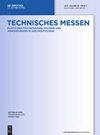Impedance spectroscopy of enlarged cochlear implant stimulation electrodes – FEM simulations considering the perilymph
IF 0.7
4区 工程技术
Q4 INSTRUMENTS & INSTRUMENTATION
引用次数: 0
Abstract
Abstract Cochlear implants are hearing prostheses for patients with severe to total hearing loss but intact auditory nerve. An external speech processor captures sound from the environment, which is subsequently converted into electrical signals and transmitted to an electrode array in the patient’s inner ear. The metallic stimulation electrodes of the electrode array electrically stimulate the spiral ganglion cells of the auditory nerve. The functionality of cochlear implants strongly depends on the possible maximum current stimulating the spiral ganglion cells, which can be affected by, e.g., cell growth around the stimulation electrodes. This in turn decreases the stimulation efficiency leading to decreased hearing. Cell growth, implant position and other changes in the surrounding medium are reflected in a change of the impedance of the stimulation electrodes. The impedance measurement of the stimulation electrodes is already implemented in all common cochlear implant systems to check functionality of the stimulation electrodes after implantation, but the frequency spectrum is normally not analyzed. Although this method can detect cell growth on the stimulation electrodes, it faces limitations when other interfering effects, such as changes in the perilymph and implant position, influence the impedance. This work shows impedance spectroscopic measurements using enlarged cochlear implant models to electrically analyze the surrounding medium, the perilymph, to understand changes in electrode impedance and to later monitor the stimulation efficiency of cochlear implants and to identify possible reasons for decreased hearing ability by impedance spectroscopy. In addition, we use FEM simulations to numerically model the influence of the perilymph composition on the impedance measurement. As shown by a final validation, this model can serve as a basis for an extended simulation model including implant position and cell growth monitoring to predict hearing deterioration in cochlear implant patients. In this context, this work serves as a basis for the development of a holistic prediction model and considers in the first step exclusively the influence of the perilymph composition on the impedance between two stimulation electrodes.放大人工耳蜗刺激电极的阻抗谱-考虑淋巴管周围的有限元模拟
摘要人工耳蜗是一种用于重度至全聋但听神经完好的患者的助听器。外部语音处理器从环境中捕获声音,随后将其转换为电信号并传输到患者内耳中的电极阵列。电极阵列的金属刺激电极电刺激听神经的螺旋神经节细胞。人工耳蜗的功能很大程度上取决于刺激螺旋神经节细胞的可能最大电流,而这可能受到刺激电极周围细胞生长等因素的影响。这反过来又降低了刺激效率,导致听力下降。细胞生长、植入物位置等周围介质的变化都反映在刺激电极阻抗的变化上。刺激电极的阻抗测量已经在所有常见的人工耳蜗植入系统中实现,以检查刺激电极植入后的功能,但频谱通常不进行分析。虽然这种方法可以在刺激电极上检测细胞生长,但当其他干扰效应,如淋巴管周围和植入物位置的变化,影响阻抗时,它面临局限性。这项工作展示了阻抗谱测量,使用放大的人工耳蜗模型电分析周围介质,淋巴管周围,了解电极阻抗的变化,随后监测人工耳蜗的刺激效率,并通过阻抗谱确定听力下降的可能原因。此外,我们还利用有限元方法模拟了外淋巴管组成对阻抗测量的影响。最终验证表明,该模型可以作为扩展模拟模型的基础,包括植入体位置和细胞生长监测,以预测人工耳蜗患者的听力退化。在这种情况下,这项工作为整体预测模型的发展奠定了基础,并在第一步中专门考虑了淋巴管周围成分对两个刺激电极之间阻抗的影响。
本文章由计算机程序翻译,如有差异,请以英文原文为准。
求助全文
约1分钟内获得全文
求助全文
来源期刊

Tm-Technisches Messen
工程技术-仪器仪表
CiteScore
1.70
自引率
20.00%
发文量
105
审稿时长
6-12 weeks
期刊介绍:
The journal promotes dialogue between the developers of application-oriented sensors, measurement systems, and measurement methods and the manufacturers and measurement technologists who use them.
Topics
The manufacture and characteristics of new sensors for measurement technology in the industrial sector
New measurement methods
Hardware and software based processing and analysis of measurement signals to obtain measurement values
The outcomes of employing new measurement systems and methods.
 求助内容:
求助内容: 应助结果提醒方式:
应助结果提醒方式:


